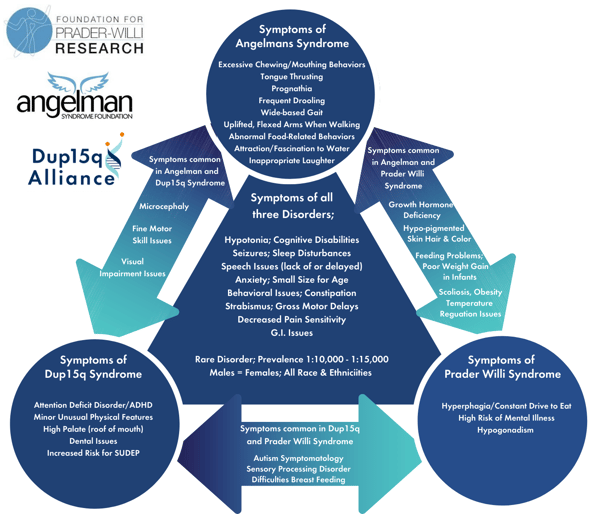Together, the Foundation for Prader-Willi Research, Angelman Syndrome Foundation and Dup15q Alliance are raising awareness of the similarities between Angelman, Dup15q, and Prader-Willi syndromes.
Prader-Willi, Angelman, and Dup15q syndromes are all distinct neurodevelopmental disorders that are caused by changes within the specific q11 to q13 region of the long arm of chromosome 15 (called 15q). This region contains a number of important genes. Unlike most other genes in the body, these genes behave differently depending on whether they are on the copy from the mom (maternal) or from the dad (paternal); this is a biological mechanism called "genomic imprinting."
- If the 15th chromosome from dad is missing information of the q11- q13 region, this causes Prader-Willi syndrome.
- If the 15th chromosome from mom is missing information of the q11-q13 region, this causes Angelman syndrome.
- If there is extra paternal or maternal q11-q13 information present on chromosome 15q, this can cause Dup15q syndrome.

Collaboration Between Syndromes
Because of the shared genetic variation, there are natural opportunities for collaborations between the 3 syndromes. One such collaborative project we have undertaken is a feasibility project to develop a newborn screening test for Prader-Willi, Angelman, Fragile X and Dup15q syndromes. This project, conducted by the Murdoch Children’s Research Institute in Melbourne, Australia, has tested the new diagnostic tool on 75,000 newborns with great accuracy.
Newborn screening means families with loved ones with Angelman, Prader-Willi, Fragile X and Dup15q syndromes will find a diagnosis in weeks instead of years, avoiding a painful diagnostic odyssey. Diagnosing individuals earlier provides the best chance of treating the symptoms and improving their quality of life much sooner.
Learn More About the Syndromes
You can learn more about Angelman and Dup15q syndromes by visiting the following patient organizations:
And an overview of Prader-Willi syndrome can be found on our About Prader-Willi syndrome page. Learn more about genetic therapy for PWS here.







